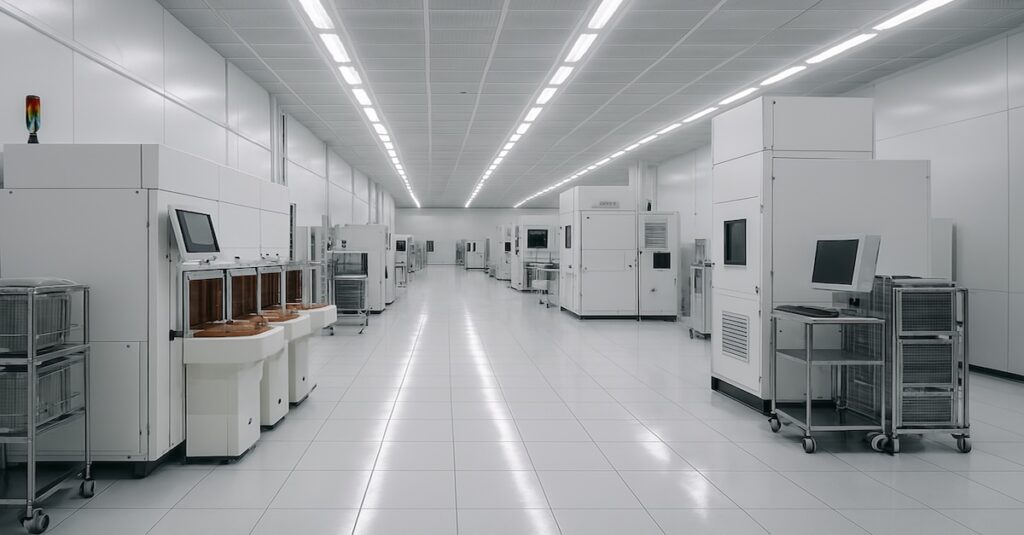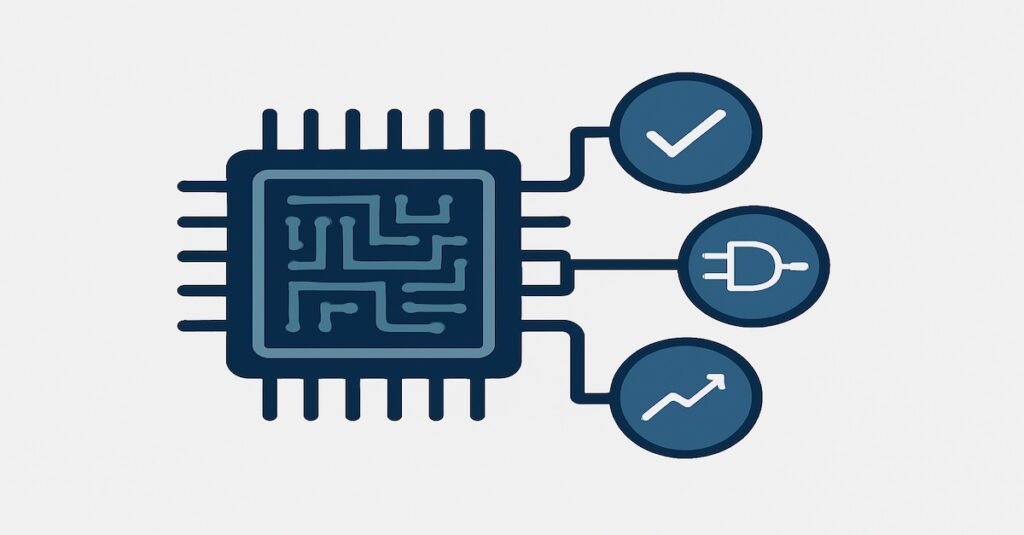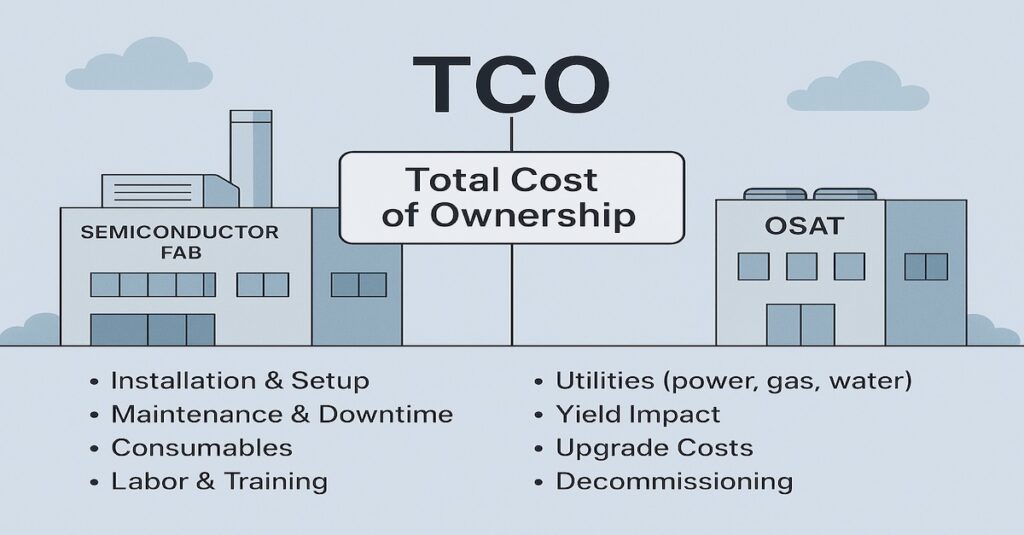Image Generated Using 4o
What Is A Semiconductor Smart Factory?
If you have spent time reading developments in the semiconductor industry, you have probably heard about the “Semiconductor Smart Factory” term. But what exactly does that mean?
In simple terms, a Semiconductor Smart Factory is like your regular manufacturing site, just a bit smarter. Think of a conventional semiconductor manufacturing (FAB or OSAT) plant, it is already pretty impressive, equipped with complex machines, operators in clean-room suits, and sophisticated processes designed to produce microscopic chips that power different applications.
But here is the twist: in a smart factory, the whole operation gets digitally interconnected, powered by advanced technologies such as real-time data analytics, artificial intelligence (AI), robotics, and extensive sensor networks.
Now, imagine this scenario: instead of manually keeping tabs on every piece of equipment, a smart factory has sensors tracking machine health and wafer quality in real-time. These sensors communicate continuously with powerful AI systems, analyzing mountains of data instantly to predict equipment failures before they occur, optimize production scheduling on the fly, and automatically adjust processes to minimize defects and maximize yield. It is like giving your entire manufacturing line a brain and eyes, empowering it to make smart decisions independently, while humans oversee and fine-tune operations from a control room.
So, why does this matter now more than ever? With chip demand skyrocketing, thanks to trends like AI, automotive electrification, and emerging computing grids, the industry faces intense pressure to produce faster, cheaper, and at a higher quality. Traditional semiconductor manufacturing sites simply cannot keep pace anymore. That is where semiconductor smart factories step in, providing a path toward better efficiency, reduced costs, and increased flexibility.
Bottom line: smart factories are not just a trendy buzzword. They are becoming the backbone for semiconductor manufacturing, transforming the way the industry operates, competes, and innovates.
Key Components Of A Semiconductor Smart Factory
Building a semiconductor smart factory is not just about developing a facility with flashy robots or AI-driven tools. It is about strategically integrating technology that fundamentally changes the way a factory works, transforming raw data into actionable decisions all by utilizing smart equipment.
To make this happen, several key components need to come together seamlessly. Let us simplify these components and understand their roles clearly:
| Component | What It Does | Why It Matters |
|---|---|---|
| Sensor Networks | Collects real-time data from equipment and environment. | Immediate issue detection; reduces downtime. |
| AI And Data Analytics | Processes data to predict issues and optimize decisions. | Boosts yield; proactive rather than reactive. |
| Automated MES (Manufacturing Execution System) | Manages and automates factory operations digitally. | Improves efficiency and traceability of wafers. |
| Robotics And Autonomous Material Handling | Automates wafer handling, transport, and processing. | Minimizes contamination risks; enhances throughput. |
| Digital Twins And Simulation | Virtual modeling of processes and equipment. | Enables safer testing, optimization, and innovation. |
| Cybersecurity Infrastructure | Protects interconnected systems and data streams. | Ensures safe operation and protects intellectual property. |
By bringing these elements together, a Semiconductor Smart Factory achieves the crucial balance between productivity, quality, flexibility, and security. It is not about blindly adopting technology but thoughtfully selecting and integrating these systems so they enhance and complement each other.
Ultimately, these components form the backbone of modern semiconductor manufacturing, preparing factories not just to meet today’s demand but to stay ahead of tomorrow’s challenges.
Benefits Of Implementing A Smart Factory Approach In Semiconductor Industry
When semiconductor companies consider moving toward smart factories, they are not just chasing tech trend. The goal is to have tangible, practical benefits that boost factory performance and profits.
First up is improved yield and productivity. Traditional semiconductor manufacturing often face costly downtime or wafer defects from minor issues. Smart factories use real-time analytics and AI to predict and prevent these problems before they occur, ensuring higher yields and steady production.
Predictive maintenance is another key advantage. Instead of reacting after equipment breaks, smart factories anticipate failures ahead of time. This proactive approach significantly cuts downtime and saves money. Then there is traceability. Smart factories digitally track every wafer, tool, and process step in real-time. This transparency speeds up troubleshooting, boosts product quality, and strengthens customer trust.
Additionally, smart factories offer unmatched flexibility. They quickly adapt to changing market demands, scaling production and integrating new processes smoothly, essential for staying competitive. Lastly, sustainability improves dramatically. Data-driven control means reduced waste, optimized energy usage, and a greener manufacturing footprint.
In short, semiconductor smart factories deliver increased yield, reduced downtime, enhanced flexibility, and better sustainability, all essential for staying ahead in today’s competitive market.
Takeaway
Transitioning to a Semiconductor Smart Factory model is no longer optional, it is becoming essential for semiconductor companies aiming to stay competitive. Smart factories directly boost yield, reduce operational costs through proactive maintenance, and enhance production flexibility.
Although initial investments can be substantial, long-term savings from reduced downtime, lower defect rates, and optimized energy consumption significantly offset these costs.
By strategically balancing upfront expenses with future efficiency gains, manufacturers ensure they are not just keeping pace but staying ahead in today’s fiercely competitive semiconductor market.






